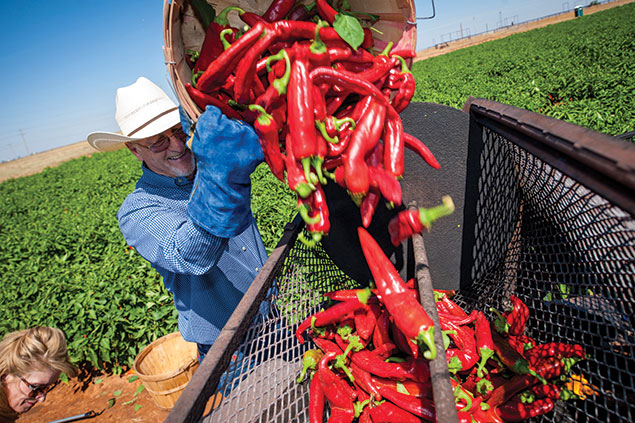
Rick Ledbetter harvesting jalapenos
Photo by Artie Limmer
Late on a Monday afternoon, the smell of roasting chile drifts over Portales, N.M., drawing a crowd to a farmers market near the courthouse square.
As people line up under a striped awning, a matching line of buckets filled with glossy chile peppers stretches to a steel roaster. Flames char the skin of the long green pods as they hiss over the roaring burner.
"We roast a bushel in about a minute and a half," chile grower Rick Ledbetter says energetically. "These were picked today for this afternoon's market. You won't get any fresher than that."
Fresh roasted chile is a state obsession during the late summer harvest season. For the Ledbetters — named New Mexico Farm Family of the Year in 2011 — satisfying the local craving started as a way for son Spencer and daughter Alex to earn summer money. Even with their son now an engineer and their daughter in college, Rick and Evelyn Ledbetter still supply two farmers markets and three restaurants.
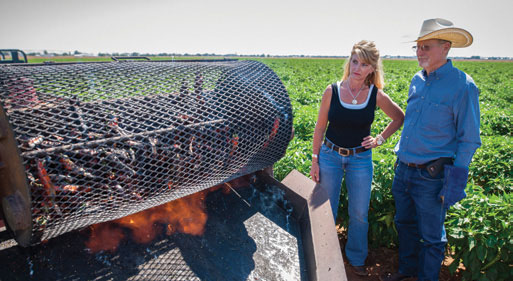
Rick and Evelyn Ledbetter turn up the heat at their Portales farm, roasting long green chile that has ripened and turned red. In addition to selling their green chile directly to consumers, the family grows paprika and jalapeños for commercial processing.
Photo by Artie Limmer
"You get to know people who come back year after year," Evelyn says of the markets, which after about 16 years feel like family reunions. "People give us hugs and say, 'We're so glad you're back.'"
The friendships and direct connection to consumers enhance Rick's commercial farming operation.
"It's a lot of work, but it turned into more than I ever thought it could," says Rick, who farms about 1,000 acres of his own and custom-farms 1,500 acres for a dairy. The only commercial chile grower in this part of eastern New Mexico, he also grows paprika, jalapeños, cotton, corn, grain sorghum and wheat.
Peanuts to Peppers
Chile has become the heart of the farm, but it took a while to get there.
Rick speaks fondly of his close partnership with his late father, who helped him get his start growing peanuts in the sandy soil west of Portales. They later leased more land to grow potatoes, one of many crops they explored together in search of a reliable return. Rick and Evelyn even scheduled their wedding around the potato harvest 31 years ago, shortly before they bought a farm a stone's throw from the Texas state line.
After his dad retired in the 1990s, Rick continued to explore new frontiers, installing GPS on the equipment, improving his irrigation efficiency and diversifying even more.
"We have tried peanuts, corn, alfalfa, cotton, milo, hay, green beans, black-eyed peas, apples, onions, carrots, potatoes — a great success and huge failure," Evelyn says, pausing at that last crop.
"Yeah, one year it was a great success and the next it was a failure," Rick says, laughing about the time they plowed up 500 acres of potatoes after the price plummeted. "The cows loved 'em."
Just when they were ready to give up on vegetables, they learned about paprika, a mild chile rich in red pigments.
"It's a natural coloring agent, and has a lot of uses," says Rick, who planted their first paprika in the early 2000s. "The beauty is it was a contract. I knew what it was worth the day I planted it."
Paprika proved a success for the family and New Mexico, where it now represents 40 percent of the state's chile acreage. The Ledbetters also commercially grow jalapeños for powdered spices, and have a 20-acre patch of long green chile for the farmers markets.
"Chile is much more valuable than anything else we're growing," Rick says. "It has a lot more profit potential, but it's a lot more expensive to grow. It's labor-intensive, and labor is hard to get."
An Old-Fashioned Crop
He calls chile an old-fashioned crop that has to be hand-weeded, hand-thinned and — in the case of long green chile — hand-picked. With about 200 acres of chile, he hired about 55 workers last year, mostly to hoe weeds, and says the challenge of finding labor has made many chile growers scale back or move on.
Dr. Stephanie Walker, Extension vegetable specialist with New Mexico State University, is one researcher trying to find a way to mechanically harvest green chile and remove the stems.
She calls Rick an asset both for his skill as a grower and his active involvement in two organizations — as chairman of the New Mexico Chile Commission and treasurer of the New Mexico Chile Association — that fund research into mechanization, new cultivars, and pest and disease management.
"Chile is part of the heart and soul of this state, but it has its challenges," Walker says. "It's the die-hard, excellent growers who have figured out the way to successfully grow green or red chile. Rick is a sterling example. He is very, very valuable both for his passion and his great concern for the chile industry in New Mexico."
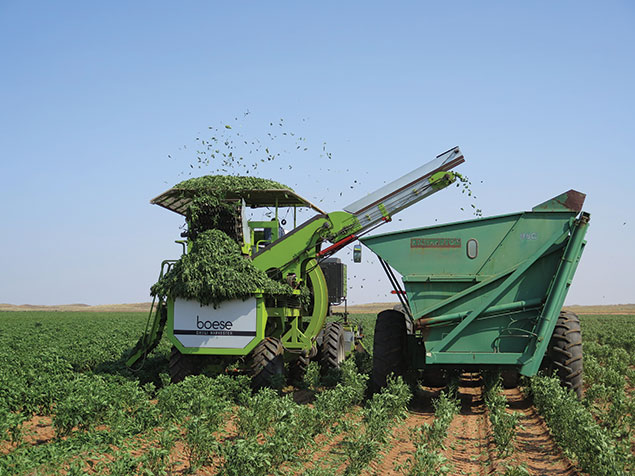
While all chile is labor-intensive, the Ledbetters can machine-harvest two types — super-hot jalapeños that are dehydrated for spices and paprika that is processed for natural red food coloring. Long green chile must be picked by hand.
Photo by Christine Forrest
Serving the Industry and Community
One of chile's biggest champions, Rick also serves on a board overseeing New Mexico Certified Chile, a nationwide labeling program that the chile association launched last year, and is treasurer of the Roosevelt Soil and Water Conservation District. Previously, he served on the state's Peanut Research Board.
He feels it's important for farmers to be engaged, whether that's talking to consumers at a farmers market or serving on a board.
"I used to be perfectly happy sitting on the outside looking in, saying, 'They can take care of it,'" he says. "But I came to the realization that there are things we have to deal with. I probably should have been involved long before I was."
Evelyn shares his commitment. The director of payroll at the local hospital, she also is president of the board at Roosevelt County Electric Cooperative, which supplies power to more than 3,300 consumers in four counties. About 40 percent of the co-op's electricity is used for irrigation, an input of great importance in this semi-arid region.
She calls the utility a strong co-op with a lot of community support.
"It's a big part of people's lives," she says, describing the co-op's storm relief efforts, education programs and scholarships. "When you're owned by your members, you have that cooperative spirit."
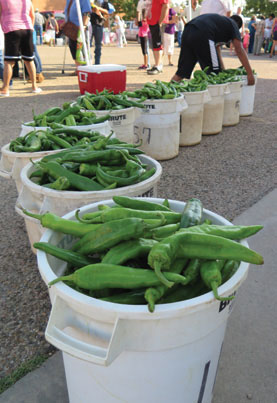
Bushels of long green chile, a pod type also known as New Mexican chile, wait their turn for the roaster at the Portales Farmers Market. Depending on variety and growing conditions, green chile can be as mild as a bell pepper or as hot as a jalapeño, or about 150 to 10,000 Scoville Heat Units.
Photo by Christine Forrest
Lifelong Co-op Members
In addition to powering the farm through an electric co-op, the Ledbetters get high-speed Internet from a telephone co-op, process their cotton at a co-op gin and finance their farming operation through Ag New Mexico, a Farm Credit lending cooperative.
Rick was a high school senior when he took out his first crop loan for $30,000, but you could say he's been a Farm Credit member since the day he was born.
"Matter of fact, my dad was digging peanuts, and went to the bank to get some money to get me out of the hospital and finish the crop," he says. "The banker said, 'Son, we don't lend money for babies.' My dad walked out and thought, 'What am I going to do?'"
A fellow farmer took him to the Production Credit Association of Eastern New Mexico, now Ag New Mexico, where the family has done business ever since.
"When I spoke to the members at the annual meeting one year," Evelyn says, "one of the things I said is the association has always been in our corner, through the good and the bad."
Mike Burns, a senior vice president who has worked at the association's Clovis office for 25 years, calls the Ledbetters great members of the association and the agriculture community.
"Rick's always done really well on his farm with what he's producing, and he's done a fine, fine job at growing chile," he says. "I've been eating green chile all my life, and theirs is really good."
Distinctive Flavor
The Ledbetters might be his customers, but the tables turn during green chile season, when Mike and his wife stock up on the family's two hottest varieties. The Ledbetters also grow two milder varieties for people who aren't looking for heat, but crave green chile's distinctive flavor.
"My dad once said, 'Man, it's so cool to be part of a legal addiction,'" Rick says.
David Lucero, director of the New Mexico Department of Agriculture Marketing and Development Division, agrees that a taste of green chile will leave you wanting more.
"There's an old saying here in New Mexico: 'Man, I need my chile fix,'" says Lucero, who invited Rick to join the New Mexico Chile Commission several years ago.
Thanks to the department's Get Your Fix program, which teaches retailers how to handle the state's signature crop, consumers can satisfy their craving for fresh and roasted New Mexico green chile at about 2,300 stores across the country.
Pick of the Crop
Out at the farm, Rick makes his rounds before getting ready for the afternoon farmers market. As he steps out of his pickup, a savory aroma hangs over a field of paprika that's turning redder and sweeter as it ripens.
"Can you smell it?" he asks. "You can always smell a chile field."
Next he checks on a crew that's mechanically harvesting jalapeños in another field.
"Now, I'll forewarn you," he says. "These are hot, hot, hot, and the harvester breaks that vapor out. You may get to sneezin' and snortin'."
Back in the truck, he pauses on top of a dune to admire the evenness of the corn before heading to his green chile patch 20 miles away. It's a long drive, but the small farm passed down from his grandparents is important to the operation.
"It's a nice little niche," he says of the green chile they grow there for the farmers markets. "We enjoy it. Like Evelyn says, it's a big ol' hugfest when we start to roasting chile."
As Rick brings in his 42nd crop, the couple is also thinking about the future. When the time comes for him to hang up his straw hat, one thing is likely to continue.
"If I ever retire, I have to keep at least one farm," he says with a laugh. "A few people have said, 'You can retire, but you can't stop growing that chile.'"
– Staff
New Mexico Chile Facts
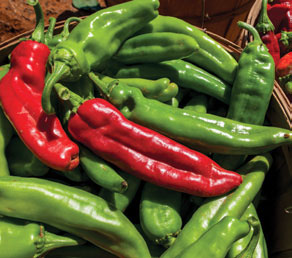
Photo by Artie Limmer
Chile has been grown in New Mexico for over 400 years, introduced from Mexico by Spanish explorers or Indian traders.
Varieties come in many sizes, shapes and heat levels. Fiery capsaicin is concentrated in the veins, making a chile hottest near the stem.
The long green chile, a new pod type introduced by New Mexico State University in 1913, helped establish the Mexican food industry in the United States. Once roasted and peeled, it is stuffed, mixed into stews and salsas, or draped on everything from eggs to enchiladas.
"Red or green?" The official state question refers to a preference for sauce made with long green chile or red chile — two stages of the same species.
The No. 1 state for chile acreage produces many chile types:
- Long green chile is sold fresh, frozen and canned.
- Long red chile and some paprika is dehydrated for sauces and spices.
- Paprika is rich in red pigments that are extracted to color processed meats, cheeses, sauces, poultry feed and other products.
- Cayenne is used in powdered spices and Cajun-style hot sauce.
- Jalapeños are canned, frozen, dehydrated and sold fresh.
Sources: New Mexico Department of Agriculture, New Mexico State University, USDA